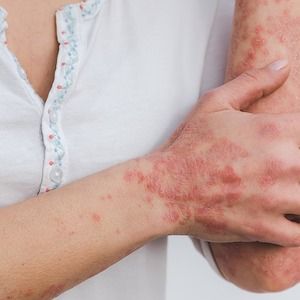Article
Psoriasis Patients with Lupus Erythematosus Skew Female, More Likely to Have Joint Involvement
Author(s):
In a recent study, patients with psoriasis and coexistent lupus erythematosus were analyzed regarding their clinical characteristics, condition management, and quality of life.

A cross-sectional study on clinical characteristics, life quality, and condition management of psoriasis patients with coexistent lupus erythematosus (LE) finds that this type of combined condition is uncommon, shows a female preponderance, and is more likely to result in joint involvement of the conditions.
The study was led by Teck Sheng Gan, MD, of the Hospital Kuala Lumpur Department of Dermatology in Malaysia. It was designed to assess psoriasis patients’ quality of life with and without LE so as to increase clinician awareness of the differing needs of these kinds of patients.
“Psoriasis patients with coexistent LE were uncommon, displayed a female preponderance, were more likely to have joint involvement, and had greater quality of life impairment than those without LE,” Gan and colleagues wrote. “LE preceded psoriasis in most of these patients, and systemic LE was the most common subtype.”
Background
The investigators used a retrospective, cross-sectional study, with psoriasis patients included who had been added to the Malaysian Psoriasis Registry (MPR) in the period between January of 2007 and December of 2018.
The research team included data from a total of 21,735 psoriasis patients, with only 0.16% (34) of them having both LE and psoriasis. Their data on psoriasis patients was taken from the MPR at enrollment, and their data for patients with coexistent psoriasis and LE was gathered when their conditions of concomitant LE were first reported.
The MPR registry contains demographic, disease severity, comorbidity, and type-of-treatment data, in addition to other information. Patients in the registry are given the health-related quality of life (HRQoL) assessment as well as the Dermatology Life Quality Index (DLQI) questionnaire, and the DLQI was used in part for the investigators’ assessment.
Findings
The study results indicated that of the 34 coexistent cases, in 16 of them (65%) LE preceded their psoriasis. The investigators also found that psoriasis patients facing LE reported earlier ages of psoriasis onset (27.56 ± 11.51 compared to 33.31 ± 16.94 years, P = 0.006) as opposed to those without LE.
The research team also noted the significant female preponderance among the 34 cases, reporting the male to female ratio of 1:5.8 (P < 0.001) for patients with both conditions compared with those without LE.
Additionally, the investigators noted that psoriasis patients with coexistent LE showed higher psoriatic arthropathy rates (26.5% versus 13.0%, P = 0.02) and substantially higher rates of reported impairment of life quality (DLQI >10; 57.6% versus 40.3%, P = 0.04) compared to those without LE.
They also noted higher incidences of lupus nephritis among psoriasis patients with LE (72.7% compared to 40%). Also, they noted that hematological abnormalities (50% compared to 20%) were greater among patients with LE preceding psoriasis compared with those with psoriasis preceding LE.
Some other facts included in their study were that hydroxychloroquine had triggered psoriasis onset for 24.1% (7) of patients, and that those with LE had a higher likelihood of having been given systemic psoriasis treatment versus those without reported LE (30.3% versus 14.2%, P = 0.008).
“Psoriasis patients with coexistent LE in the MPR were uncommon (0.16%), displayed a female preponderance, and were more likely to have joint involvement, an earlier age of psoriasis onset and to suffer greater impairment to their quality of life compared with psoriasis patients without LE,” they wrote. “Lupus erythematosus preceded psoriasis in more than half of the patients in our cohort, and SLE was the most common subtype of LE reported.”
The study, “Clinical characteristics, management, and quality of life of psoriasis patients with coexistent lupus erythematosus: Data from the Malaysian Psoriasis Registry,” was published online in the International Journal of Rheumatic Diseases.





